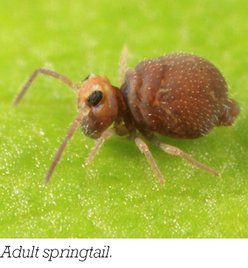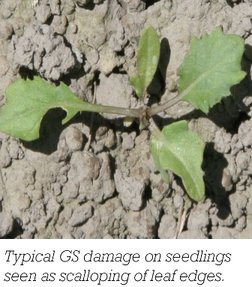Springtails
Bourletiella sp.
There are several species of springtails, the only one causing damage to brassicas being the garden springtail (Bourletiella hortensis). They are found throughout NZ, with little known about their lifecycle.
Identification
Garden springtails (GS) are soft-bodied, brown to black in colour and up to 1 mm long when fully developed. The bodies are globular and have a springing device which is folded under the body when not in use. Mouthparts are adapted for chewing, and eggs are laid in the soil. Several generations may be produced in a single year.

GS are hard to detect with the naked eye against the soil or plant surface, so to test if they are present in a crop, a piece of white card can be used to pick them up. Place the card on the soil surface and tapping around it, and watch for GS jumping onto the card.
The nymph is similar to the adult in every respect, just smaller.
Damage to brassicas can occur as soon as the plant cotyledons emerge, which can result in stem damage even before they grow above the soil surface. Peak GS populations occur in spring and autumn.
Damage to seedling leaves appears as scalloping of the edges of the leaves or as small pits or shot holes. The latter damage can also be caused by wind blown soil particles as the plants emerge.

Prevention and management
Seed treatment, such as AGRICOTE Brassica, or the application of a suitable insecticide offers the best early protection against this pest.
Early detection of this pest is essential. To avoid damage, preventative sprays should be applied at or just prior to crop emergence.

